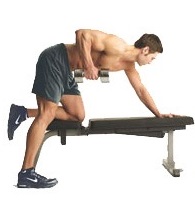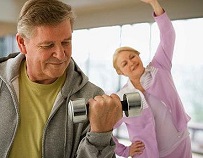our fitness tips

What Are the Best Strength Training Exercises?
0
 Most people have an idea now that strength training can be highly beneficial towards their fitness goals – whether those goals are improved athletic performance, weight loss, strength gains or injury rehabilitation. What many people are unsure about, however, is what the best strength training exercises are. They often wonder whether they should be using free weights or machines, whether kettlebells are best, or dumbells, or barbells, and exactly which exercises they should be doing.
Most people have an idea now that strength training can be highly beneficial towards their fitness goals – whether those goals are improved athletic performance, weight loss, strength gains or injury rehabilitation. What many people are unsure about, however, is what the best strength training exercises are. They often wonder whether they should be using free weights or machines, whether kettlebells are best, or dumbells, or barbells, and exactly which exercises they should be doing.
While every exercise has benefits for some people, in general the best strength training exercises are the compound lifts. These are the exercises that promote overall strength – exercising all of the body. This builds functional strength and also has the benefit of preparing the body for more focused training at a later date. It is not a good idea to start doing isolation exercises with very heavy weights if you have a weak core and weak shoulders, for example, because while most of the muscles in your body will be able to cope, the one part in the chain that lets you down could lead to serious injury.
So, here is a quick overview of some of the best strength training exercises:
The Squat
The squat is a great exercise and one that is often overlooked. The stereotype of the beach-loving gym guy that spends endless hours doing biceps curls but that has underdeveloped legs exists for a reason. There is a lot of pride associated with having big biceps and a good bench press record, but squats are less glamorous. Squats are also very hard work, so few people enjoy doing them. However, done right squats develop the legs in a way that other lifts do not, and they also develop the core muscles. There are some that theorise that squatting heavy weights can actually promote the release of hormones that help you to build more muscle. So, in essence, squatting heavy helps to make you much stronger, and could improve your bench press total in the long term too.
Deadlift
The deadlift is another great strength training exercise. This exercise is important because it helps you to get stronger core muscles, as well as building up your legs and also your grip. If you are a manual laborer and you need functional strength then this is a great exercise.
Turkish Getups
But what about if you do not have access to a barbell? Well, Turkish getups are a great exercise, and one that can be done with just a kettlebell or dumbell held overhead. The beauty of this exercise is that if you have space to lie down and stand back up again, you have space to do a Turkish Getup. So, you can take a small kettlebell with you when you are traveling and do the exercise in a hotel room.
Anyone Can Get Strong
Anyone can get strong, as long as they are willing to exercise on a regular basis. You do not need to pay for an expensive gym membership or spend a lot of money on supplements. Simply taking the time to challenge yourself by lifting heavy weights – or even doing bodyweight exercises – a few times a week will help you to put on quality muscle mass in the long term. If you combine this with calorie counting, you can lose fat and get the body you have always wanted, or manage your weight so that you end up in the correct weight class for your chosen sport. There is no magic or mystery – strength training is all about dedication.
For some other examples of great strength training exercises feel free to check the video below… good luck!


Safe And Effective Exercises For Older Adults
0
 A major key to staying young and healthy as your body grows older is keeping it flexible and strong. Aging does not need to include becoming weaker and stiffer. Increasing your flexibility and strength as you grow older is easier than you may think; there is no need to join a gym or go running in order to keep fit. There are certain exercises for older adults that you can do in your own home that will only take a few minutes a day and that can make all the difference to your quality of life and your health.
A major key to staying young and healthy as your body grows older is keeping it flexible and strong. Aging does not need to include becoming weaker and stiffer. Increasing your flexibility and strength as you grow older is easier than you may think; there is no need to join a gym or go running in order to keep fit. There are certain exercises for older adults that you can do in your own home that will only take a few minutes a day and that can make all the difference to your quality of life and your health.
Sitting Exercises
These are exercises you can do while seated and they are ideal for those who either cannot stand up at all, or who have not yet developed the strength or balance for standing for periods of time. In all of these exercises, you will need to sit with your back away from the back of the chair, and with your back as straight as possible.
Start with your arms either side of you, hanging straight down and slowly lift them above your head so that they are straight up towards the ceiling. Hold them there for two counts, and then slowly lower them to the starting position. The key to this exercise is that it needs to be done very slowly and in a controlled manner; this will make sure you are making the most of your muscles.
Keeping one foot flat on the floor, lift the other leg with the knee bent up to a height where it feels comfortable then slowly lower it to the floor. Do the same with the other leg. It is important in this exercise, as with the previous one, to use a slow and controlled motion in order to get the benefit from the activity.
Standing Exercises
Stand behind a chair and hold onto the back of the chair with both hands. With your feet shoulder width apart and your toes turned just slightly out slowly lower yourself, pushing your hips out behind you as if you were going to sit down on a low wall. When you reach a comfortable level, slowly straighten your legs to bring yourself back to the standing position again. Make sure that you are not putting weight on your arms – the reason you are holding onto the back of the chair is only for balance, not to help with the squat.
Standing in front of a wall arm’s length away from it, place both palms on the wall at shoulder height. Slowly bend your elbows, bringing your body closer to the wall in a controlled movement until your face is almost touching the wall, and then slowly straighten your elbows again. The more slowly you do this exercise, the more benefit you will get from it.
Do each of these exercises for older adults as many times in a row as you can without pain. There should be no pain, only a stretching of the muscles. Take a little rest and then see if you can do the same number again. Keep note of how many times you did that particular exercise today, and see if you can add one more next time. Give yourself at least one day rest in between exercise sessions to allow your muscles to repair and build up strength.

 Hey friends and welcome! In our blog you will find detailed reviews and useful information about the most popular fitness programs online. We hope you will find our advice to be helpful for you and please feel free to contact us if you have any question.
All the best! Madison and Riley
Hey friends and welcome! In our blog you will find detailed reviews and useful information about the most popular fitness programs online. We hope you will find our advice to be helpful for you and please feel free to contact us if you have any question.
All the best! Madison and Riley  If you are a webmaster that wants to use some of the content found on our site in your personal website you must get our written approval first.
If you are a webmaster that wants to use some of the content found on our site in your personal website you must get our written approval first.